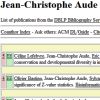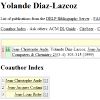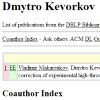| |
   
Jean-Christophe Aude,
Yolande Diaz-Lazcoz,
Jean-Jacques Codani and
Jean-Loup Risler. Applications of the Pyramidal Clustering Method to Biological Objects. In CC, Vol. 23(3-4):303-315, 1999.
Keywords: from distances, phylogenetic network, phylogeny, Program Pyramids, pyramid, reconstruction, software, visualization.
Note: http://dx.doi.org/10.1016/S0097-8485(99)00006-6.
|
|
| |
 
Hans-Jürgen Bandelt and
Andreas W. M. Dress. Weak hierarchies associated with similarity measures: an additive clustering technique. In BMB, Vol. 51:113-166, 1989.
Keywords: abstract network, clustering, from distances, from trees, phylogenetic network, phylogeny, Program WeakHierarchies, reconstruction, weak hierarchy.
Note: http://dx.doi.org/10.1007/BF02458841.
Toggle abstract
"A new and apparently rather useful and natural concept in cluster analysis is studied: given a similarity measure on a set of objects, a sub-set is regarded as a cluster if any two objects a, b inside this sub-set have greater similarity than any third object outside has to at least one of a, b. These clusters then form a closure system which can be described as a hypergraph without triangles. Conversely, given such a system, one may attach some weight to each cluster and then compose a similarity measure additively, by letting the similarity of a pair be the sum of weights of the clusters containing that particular pair. The original clusters can be reconstructed from the obtained similarity measure. This clustering model is thus located between the general additive clustering model of Shepard and Arabie (1979) and the standard hierarchical model. Potential applications include fitting dendrograms with few additional nonnested clusters and simultaneous representation of some families of multiple dendrograms (in particular, two-dendrogram solutions), as well as assisting the search for phylogenetic relationships by proposing a somewhat larger system of possibly relevant "family groups", from which an appropriate choice (based on additional insight or individual preferences) remains to be made. © 1989 Society for Mathematical Biology."
|
|
| |
 
Hans-Jürgen Bandelt and
Andreas W. M. Dress. A canonical decomposition theory for metrics on a finite set. In Advances in Mathematics, Vol. 92(1):47-105, 1992.
Keywords: abstract network, circular split system, from distances, split, split decomposition, split network, weak hierarchy, weakly compatible.
Toggle abstract
"We consider specific additive decompositions d = d1 + ... + dn of metrics, defined on a finite set X (where a metric may give distance zero to pairs of distinct points). The simplest building stones are the slit metrics, associated to splits (i.e., bipartitions) of the given set X. While an additive decomposition of a Hamming metric into split metrics is in no way unique, we achieve uniqueness by restricting ourselves to coherent decompositions, that is, decompositions d = d1 + ... + dn such that for every map f:X → R with f(x) + f(y) ≥ d(x, y) for all x, y ε{lunate} X there exist maps f1, ..., fn: X → R with f = f1 + ... + fn and fi(x) + fi(y) ≥ di(x, y) for all i = 1,..., n and all x, y ε{lunate} X. These coherent decompositions are closely related to a geometric decomposition of the injective hull of the given metric. A metric with a coherent decomposition into a (weighted) sum of split metrics will be called totally split-decomposable. Tree metrics (and more generally, the sum of two tree metrics) are particular instances of totally split-decomposable metrics. Our main result confirms that every metric admits a coherent decomposition into a totally split-decomposable metric and a split-prime residue, where all the split summands and hence the decomposition can be determined in polynomial time, and that a family of splits can occur this way if and only if it does not induce on any four-point subset all three splits with block size two. © 1992."
|
|
| |
|
| |
   
Ho-Leung Chan,
Jesper Jansson,
Tak-Wah Lam and
Siu-Ming Yiu. Reconstructing an Ultrametric Galled Phylogenetic Network from a Distance Matrix. In JBCB, Vol. 4(4):807-832, 2006.
Keywords: explicit network, from distances, galled tree, phylogenetic network, phylogeny, polynomial, reconstruction.
Note: http://www.df.lth.se/~jj/Publications/dist_ugn7_JBCB2006.pdf.
Toggle abstract
"Given a distance matrix M that specifies the pairwise evolutionary distances between n species, the phylogenetic tree reconstruction problem asks for an edge-weighted phylogenetic tree that satisfies M, if one exists. We study some extensions of this problem to rooted phylogenetic networks. Our main result is an O(n2 log n)-time algorithm for determining whether there is an ultrametric galled network that satisfies M, and if so, constructing one. In fact, if such an ultrametric galled network exists, our algorithm is guaranteed to construct one containing the minimum possible number of nodes with more than one parent (hybrid nodes). We also prove that finding a largest possible submatrix M′ of M such that there exists an ultrametric galled network that satisfies M′ is NP-hard. Furthermore, we show that given an incomplete distance matrix (i.e. where some matrix entries are missing), it is also NP-hard to determine whether there exists an ultrametric galled network which satisfies it. © 2006 Imperial College Press."
|
|
| |
  
Andreas W. M. Dress,
Daniel H. Huson and
Vincent Moulton. Analyzing and visualizing distance data using SplitsTree. In DAM, Vol. 71(1):95-109, 1996.
Keywords: abstract network, from distances, phylogenetic network, phylogeny, Program SplitsTree, software, split network, visualization.
Note: http://bibiserv.techfak.uni-bielefeld.de/splits/splits.pdf.
|
|
| |

François-Joseph Lapointe. How to account for reticulation events in phylogenetic analysis: A review of distance-based methods. In Journal of Classification, Vol. 17:175-184, 2000.
Keywords: abstract network, evaluation, from distances, phylogenetic network, Program Pyramids, Program SplitsTree, Program T REX, pyramid, reconstruction, reticulogram, split network, survey, weak hierarchy.
Note: http://dx.doi.org/10.1007/s003570000016.
|
|
| |
|
| |
    
Richard C. Winkworth,
David Bryant,
Peter J. Lockhart,
David Havell and
Vincent Moulton. Biogeographic Interpretation of Splits Graphs: Least Squares Optimization of Branch Lengths. In Systematic Biology, Vol. 54(1):56-65, 2005.
Keywords: abstract network, from distances, from network, phylogenetic network, phylogeny, reconstruction, split, split network.
Note: http://www.math.auckland.ac.nz/~bryant/Papers/05Biogeographic.pdf.
|
|
| |
|
| |
|
| |
|
| |
|
| |
  
David Bryant,
Vincent Moulton and
Andreas Spillner. Consistency of the Neighbor-Net Algorithm. In AMB, Vol. 2(8), 2007.
Keywords: abstract network, consistency, from distances, NeighborNet.
Note: http://dx.doi.org/10.1186/1748-7188-2-8.
Toggle abstract
"Background: Neighbor-Net is a novel method for phylogenetic analysis that is currently being widely used in areas such as virology, bacteriology, and plant evolution. Given an input distance matrix, Neighbor-Net produces a phylogenetic network, a generalization of an evolutionary or phylogenetic tree which allows the graphical representation of conflicting phylogenetic signals. Results: In general, any network construction method should not depict more conflict than is found in the data, and, when the data is fitted well by a tree, the method should return a network that is close to this tree. In this paper we provide a formal proof that Neighbor-Net satisfies both of these requirements so that, in particular, Neighbor-Net is statistically consistent on circular distances. © 2007 Bryant et al; licensee BioMed Central Ltd."
|
|
| |
|
| |
|
| |
   
Andreas W. M. Dress,
Katharina Huber,
Jacobus Koolen and
Vincent Moulton. Compatible decompositions and block realizations of finite metrics. In EJC, Vol. 29(7):1617-1633, 2008.
Keywords: abstract network, block realization, from distances, phylogenetic network, phylogeny, realization, reconstruction.
Note: http://www.ims.nus.edu.sg/preprints/2007-21.pdf.
Toggle abstract
"Given a metric D defined on a finite set X, we define a finite collection D of metrics on X to be a compatible decomposition of D if any two distinct metrics in D are linearly independent (considered as vectors in RX × X), D = ∑d ∈ D d holds, and there exist points x, x′ ∈ X for any two distinct metrics d, d′ in D such that d (x, y) d′ (x′, y) = 0 holds for every y ∈ X. In this paper, we show that such decompositions are in one-to-one correspondence with (isomorphism classes of) block realizations of D, that is, graph realizations G of D for which G is a block graph and for which every vertex in G not labelled by X has degree at least 3 and is a cut point of G. This generalizes a fundamental result in phylogenetic combinatorics that states that a metric D defined on X can be realized by a tree if and only if there exists a compatible decomposition D of D such that all metrics d ∈ D are split metrics, and lays the foundation for a more general theory of metric decompositions that will be explored in future papers. © 2007 Elsevier Ltd. All rights reserved."
|
|
| |
 
Dan Levy and
Lior Pachter. The Neighbor-Net Algorithm. In Advances in Applied Mathematics, Vol. 47(2):240-258, 2011.
Keywords: abstract network, circular split system, evaluation, from distances, NeighborNet, phylogenetic network, phylogeny, split network.
Note: http://arxiv.org/abs/math/0702515.
Toggle abstract
"The neighbor-joining algorithm is a popular phylogenetics method for constructing trees from dissimilarity maps. The neighbor-net algorithm is an extension of the neighbor-joining algorithm and is used for constructing split networks. We begin by describing the output of neighbor-net in terms of the tessellation of M̄0n(R) by associahedra. This highlights the fact that neighbor-net outputs a tree in addition to a circular ordering and we explain when the neighbor-net tree is the neighbor-joining tree. A key observation is that the tree constructed in existing implementations of neighbor-net is not a neighbor-joining tree. Next, we show that neighbor-net is a greedy algorithm for finding circular split systems of minimal balanced length. This leads to an interpretation of neighbor-net as a greedy algorithm for the traveling salesman problem. The algorithm is optimal for Kalmanson matrices, from which it follows that neighbor-net is consistent and has optimal radius 12. We also provide a statistical interpretation for the balanced length for a circular split system as the length based on weighted least squares estimates of the splits. We conclude with applications of these results and demonstrate the implications of our theorems for a recently published comparison of Papuan and Austronesian languages. © 2010 Elsevier Inc. All rights reserved."
|
|
| |

Frederick A. Matsen. ConstNJ: an algorithm to reconstruct sets of phylogenetic trees satisfying pairwise topological constraints. In JCB, Vol. 17(6):799-818, 2010.
Keywords: from distances, Program constNJ, reconstruction.
Note: http://arxiv.org/abs/0901.1598v2.
Toggle abstract
"This article introduces constNJ (constrained neighbor-joining), an algorithm for phylogenetic reconstruction of sets of trees with constrained pairwise rooted subtree-prune-regraft (rSPR) distance. We are motivated by the problem of constructing sets of trees that must fit into a recombination, hybridization, or similar network. Rather than first finding a set of trees that are optimal according to a phylogenetic criterion (e.g., likelihood or parsimony) and then attempting to fit them into a network, constNJ estimates the trees while enforcing specified rSPR distance constraints. The primary input for constNJ is a collection of distance matrices derived from sequence blocks which are assumed to have evolved in a tree-like manner, such as blocks of an alignment which do not contain any recombination breakpoints. The other input is a set of rSPR constraint inequalities for any set of pairs of trees. constNJ is consistent and a strict generalization of the neighbor-joining algorithm; it uses the new notion of maximum agreement partitions (MAPs) to assure that the resulting trees satisfy the given rSPR distance constraints. Copyright 2010, Mary Ann Liebert, Inc."
|
|
| |
 
Mihaela Baroni and
Mike Steel. Accumulation Phylogenies. In ACOM, Vol. 10(1):19-30, 2006.
Keywords: abstract network, from clusters, from distances, phylogenetic network, phylogeny, polynomial, reconstruction, regular network.
Note: http://citeseerx.ist.psu.edu/viewdoc/summary?doi=10.1.1.137.1960.
Toggle abstract
"We investigate the computational complexity of a new combinatorial problem of inferring a smallest possible multi-labeled phylogenetic tree (MUL tree) which is consistent with each of the rooted triplets in a given set. We prove that even the restricted case of determining if there exists a MUL tree consistent with the input and having just one leaf duplication is NP-hard. Furthermore, we show that the general minimization problem is NP-hard to approximate within a ratio of n 1-ε for any constant 0<ε≤1, where n denotes the number of distinct leaf labels in the input set, although a simple polynomial-time approximation algorithm achieves the approximation ratio n. We also provide an exact algorithm for the problem running in O *(7 n ) time and O *(3 n ) space. © 2009 Springer-Verlag Berlin Heidelberg."
|
|
| |
  
Changiz Eslahchi,
Mahnaz Habibi,
Reza Hassanzadeh and
Ehsan Mottaghi. MC-Net: a method for the construction of phylogenetic networks based on the Monte-Carlo method. In BMCEB, Vol. 10:254, 2010.
Keywords: abstract network, circular split system, from distances, heuristic, phylogenetic network, Program MC-Net, Program SplitsTree, software, split, split network.
Note: http://dx.doi.org/10.1186/1471-2148-10-254.
Toggle abstract
"Background. A phylogenetic network is a generalization of phylogenetic trees that allows the representation of conflicting signals or alternative evolutionary histories in a single diagram. There are several methods for constructing these networks. Some of these methods are based on distances among taxa. In practice, the methods which are based on distance perform faster in comparison with other methods. The Neighbor-Net (N-Net) is a distance-based method. The N-Net produces a circular ordering from a distance matrix, then constructs a collection of weighted splits using circular ordering. The SplitsTree which is a program using these weighted splits makes a phylogenetic network. In general, finding an optimal circular ordering is an NP-hard problem. The N-Net is a heuristic algorithm to find the optimal circular ordering which is based on neighbor-joining algorithm. Results. In this paper, we present a heuristic algorithm to find an optimal circular ordering based on the Monte-Carlo method, called MC-Net algorithm. In order to show that MC-Net performs better than N-Net, we apply both algorithms on different data sets. Then we draw phylogenetic networks corresponding to outputs of these algorithms using SplitsTree and compare the results. Conclusions. We find that the circular ordering produced by the MC-Net is closer to optimal circular ordering than the N-Net. Furthermore, the networks corresponding to outputs of MC-Net made by SplitsTree are simpler than N-Net. © 2010 Eslahchi et al; licensee BioMed Central Ltd."
|
|
| |

Klaus Schliep. Phangorn: Phylogenetic analysis in R. In Bioinformatics, Vol. 27(4):592-593, 2011.
Keywords: abstract network, from distances, phylogenetic network, Program Phangorn, software, split, split network.
Note: http://dx.doi.org/10.1093/bioinformatics/btq706.
Toggle abstract
"Summary: phangorn is a package for phylogenetic reconstruction and analysis in the R language. Previously it was only possible to estimate phylogenetic trees with distance methods in R. phangorn, now offers the possibility of reconstructing phylogenies with distance based methods, maximum parsimony or maximum likelihood (ML) and performing Hadamard conjugation. Extending the general ML framework, this package provides the possibility of estimating mixture and partition models. Furthermore, phangorn offers several functions for comparing trees, phylogenetic models or splits, simulating character data and performing congruence analyses. © The Author(s) 2010. Published by Oxford University Press."
|
|
| |
 
Marc Thuillard and
Vincent Moulton. Identifying and reconstructing lateral transfers from distance matrices by combining the Minimum Contradiction Method and Neighbor-Net. In JBCB, Vol. 9(4):453-470, 2011.
Keywords: from distances, lateral gene transfer, minimum contradiction, NeighborNet, phylogenetic network, phylogeny, reconstruction.
Note: http://dx.doi.org/10.1142/S0219720011005409, slides available at http://www.newton.ac.uk/programmes/PLG/seminars/062015501.html.
Toggle abstract
"Identifying lateral gene transfers is an important problem in evolutionary biology. Under a simple model of evolution, the expected values of an evolutionary distance matrix describing a phylogenetic tree fulfill the so-called Kalmanson inequalities. The Minimum Contradiction method for identifying lateral gene transfers exploits the fact that lateral transfers may generate large deviations from the Kalmanson inequalities. Here a new approach is presented to deal with such cases that combines the Neighbor-Net algorithm for computing phylogenetic networks with the Minimum Contradiction method. A subset of taxa, prescribed using Neighbor-Net, is obtained by measuring how closely the Kalmanson inequalities are fulfilled by each taxon. A criterion is then used to identify the taxa, possibly involved in a lateral transfer between nonconsecutive taxa. We illustrate the utility of the new approach by applying it to a distance matrix for Archaea, Bacteria, and Eukaryota. © 2011 Imperial College Press."
|
|
| |
 
Paul Phipps and
Sergey Bereg. Optimizing Phylogenetic Networks for Circular Split Systems. In TCBB, Vol. 9(2):535-547, 2012.
Keywords: abstract network, from distances, from splits, phylogenetic network, phylogeny, Program PhippsNetwork, reconstruction, software.
Toggle abstract
"We address the problem of realizing a given distance matrix by a planar phylogenetic network with a minimum number of faces. With the help of the popular software SplitsTree4, we start by approximating the distance matrix with a distance metric that is a linear combination of circular splits. The main results of this paper are the necessary and sufficient conditions for the existence of a network with a single face. We show how such a network can be constructed, and we present a heuristic for constructing a network with few faces using the first algorithm as the base case. Experimental results on biological data show that this heuristic algorithm can produce phylogenetic networks with far fewer faces than the ones computed by SplitsTree4, without affecting the approximation of the distance matrix. © 2012 IEEE."
|
|
| |
 
Andreas Spillner and
Vincent Moulton. Optimal algorithms for computing edge weights in planar split-networks. In Journal of Applied Mathematics and Computing, Vol. 39(1-2):1-13, 2012.
Keywords: abstract network, from distances, phylogenetic network, phylogeny, reconstruction, split, split network.
Note: http://dx.doi.org/10.1007/s12190-011-0506-z.
Toggle abstract
"In phylogenetics, biologists commonly compute split networks when trying to better understand evolutionary data. These graph-theoretical structures represent collections of weighted bipartitions or splits of a finite set, and provide a means to display conflicting evolutionary signals. The weights associated to the splits are used to scale the edges in the network and are often computed using some distance matrix associated with the data. In this paper we present optimal polynomial time algorithms for three basic problems that arise in this context when computing split weights for planar split-networks. These generalize algorithms that have been developed for special classes of split networks (namely, trees and outer-labeled planar networks). As part of our analysis, we also derive a Crofton formula for full flat split systems, structures that naturally arise when constructing planar split-networks. © 2011 Korean Society for Computational and Applied Mathematics."
|
|
| |

Stephen J. Willson. Tree-average distances on certain phylogenetic networks have their weights uniquely determined. In ALMOB, Vol. 7(13), 2012.
Keywords: from distances, from network, normal network, phylogenetic network, phylogeny, reconstruction, tree-child network.
Note: hhttp://www.public.iastate.edu/~swillson/Tree-AverageDis10All.pdf.
Toggle abstract
"A phylogenetic network N has vertices corresponding to species and arcs corresponding to direct genetic inheritance from the species at the tail to the species at the head. Measurements of DNA are often made on species in the leaf set, and one seeks to infer properties of the network, possibly including the graph itself. In the case of phylogenetic trees, distances between extant species are frequently used to infer the phylogenetic trees by methods such as neighbor-joining.This paper proposes a tree-average distance for networks more general than trees. The notion requires a weight on each arc measuring the genetic change along the arc. For each displayed tree the distance between two leaves is the sum of the weights along the path joining them. At a hybrid vertex, each character is inherited from one of its parents. We will assume that for each hybrid there is a probability that the inheritance of a character is from a specified parent. Assume that the inheritance events at different hybrids are independent. Then for each displayed tree there will be a probability that the inheritance of a given character follows the tree; this probability may be interpreted as the probability of the tree. The tree-average distance between the leaves is defined to be the expected value of their distance in the displayed trees.For a class of rooted networks that includes rooted trees, it is shown that the weights and the probabilities at each hybrid vertex can be calculated given the network and the tree-average distances between the leaves. Hence these weights and probabilities are uniquely determined. The hypotheses on the networks include that hybrid vertices have indegree exactly 2 and that vertices that are not leaves have a tree-child. © 2012 Willson; licensee BioMed Central Ltd."
|
|
| |
 
Ruogu Sheng and
Sergey Bereg. Approximating Metrics with Planar Boundary-Labeled Phylogenetic Networks. In JBCB, Vol. 10(6):1250017, 2012.
Keywords: abstract network, from distances, phylogenetic network, phylogeny, reconstruction.
Toggle abstract
"Phylogenetic networks are useful for visualizing evolutionary relationships between species with reticulate events such as hybridizations and horizontal gene transfers. In this paper, we consider the problem of constructing undirected phylogenetic networks that (1) are planar graphs and (2) admit embeddings in the plane where the vertices labeling all taxa are on the boundary of the network. We develop a new algorithm for constructing phylogenetic networks satisfying these constraints. First, we show that only approximate networks can be constructed for some distance matrices with at least five taxa. Then we prove that any five-point metric can be represented approximately by a planar boundary-labeled network with guaranteed fit value of 94.79. We extend the networks constructed in the proof to design an algorithm for computing planar boundary-labeled networks for any number of taxa. © 2012 Imperial College Press."
|
|
| |

Stephen J. Willson. Reconstruction of certain phylogenetic networks from their tree-average distances. In BMB, Vol. 75(10):1840-1878, 2013.
Keywords: explicit network, from distances, galled tree, normal network, phylogenetic network, phylogeny, unicyclic network.
Note: http://www.public.iastate.edu/~swillson/Tree-AverageReconPaper9.pdf.
Toggle abstract
"Trees are commonly utilized to describe the evolutionary history of a collection of biological species, in which case the trees are called phylogenetic trees. Often these are reconstructed from data by making use of distances between extant species corresponding to the leaves of the tree. Because of increased recognition of the possibility of hybridization events, more attention is being given to the use of phylogenetic networks that are not necessarily trees. This paper describes the reconstruction of certain such networks from the tree-average distances between the leaves. For a certain class of phylogenetic networks, a polynomial-time method is presented to reconstruct the network from the tree-average distances. The method is proved to work if there is a single reticulation cycle. © 2013 Society for Mathematical Biology."
|
|
| |
  
Alexey A. Morozov,
Yuri P. Galachyants and
Yelena V. Likhoshway. Inferring Phylogenetic Networks from Gene Order Data. In BMRI, Vol. 2013(503193):1-7, 2013.
Keywords: abstract network, from distances, from gene order, NeighborNet, phylogenetic network, phylogeny, Program SplitsTree, reconstruction, split decomposition, split network.
Toggle abstract
"Existing algorithms allow us to infer phylogenetic networks from sequences (DNA, protein or binary), sets of trees, and distance matrices, but there are no methods to build them using the gene order data as an input. Here we describe several methods to build split networks from the gene order data, perform simulation studies, and use our methods for analyzing and interpreting different real gene order datasets. All proposed methods are based on intermediate data, which can be generated from genome structures under study and used as an input for network construction algorithms. Three intermediates are used: set of jackknife trees, distance matrix, and binary encoding. According to simulations and case studies, the best intermediates are jackknife trees and distance matrix (when used with Neighbor-Net algorithm). Binary encoding can also be useful, but only when the methods mentioned above cannot be used. © 2013 Alexey Anatolievich Morozov et al."
|
|
| |
  
Sarah Bastkowski,
Andreas Spillner and
Vincent Moulton. Fishing for minimum evolution trees with Neighbor-Nets. In IPL, Vol. 114(1-2):3-18, 2014.
Keywords: circular split system, from distances, NeighborNet, phylogeny, polynomial.
Toggle abstract
"In evolutionary biology, biologists commonly use a phylogenetic tree to represent the evolutionary history of some set of species. A common approach taken to construct such a tree is to search through the space of all possible phylogenetic trees on the set so as to find one that optimizes some score function, such as the minimum evolution criterion. However, this is hampered by the fact that the space of phylogenetic trees is extremely large in general. Interestingly, an alternative approach, which has received somewhat less attention in the literature, is to instead search for trees within some set of bipartitions or splits of the set of species in question. Here we consider the problem of searching through a set of splits that is circular. Such sets can, for example, be generated by the NeighborNet algorithm for constructing phylogenetic networks. More specifically, we present an O(n4) time algorithm for finding an optimal minimum evolution tree in a circular set of splits on a set of species of size n. In addition, using simulations, we compare the performance of this algorithm when applied to NeighborNet output with that of FastME, a leading method for searching for minimum evolution trees in tree space. We find that, even though a circular set of splits represents just a tiny fraction of the total number of possible splits of a set, the trees obtained from circular sets compare quite favorably with those obtained with FastME, suggesting that the approach could warrant further investigation. © 2013 Elsevier B.V."
|
|
| |
   
Alberto Apostolico,
Matteo Comin,
Andreas W. M. Dress and
Laxmi Parida. Ultrametric networks: a new tool for phylogenetic analysis. In Algorithms for Molecular Biology, Vol. 8(7):1-10, 2013.
Keywords: abstract network, from distances, phylogenetic network, phylogeny, Program Ultranet.
Note: http://dx.doi.org/10.1186/1748-7188-8-7.
Toggle abstract
"Background: The large majority of optimization problems related to the inference of distance-based trees used in phylogenetic analysis and classification is known to be intractable. One noted exception is found within the realm of ultrametric distances. The introduction of ultrametric trees in phylogeny was inspired by a model of evolution driven by the postulate of a molecular clock, now dismissed, whereby phylogeny could be represented by a weighted tree in which the sum of the weights of the edges separating any given leaf from the root is the same for all leaves. Both, molecular clocks and rooted ultrametric trees, fell out of fashion as credible representations of evolutionary change. At the same time, ultrametric dendrograms have shown good potential for purposes of classification in so far as they have proven to provide good approximations for additive trees. Most of these approximations are still intractable, but the problem of finding the nearest ultrametric distance matrix to a given distance matrix with respect to the L∞ distance has been long known to be solvable in polynomial time, the solution being incarnated in any minimum spanning tree for the weighted graph subtending to the matrix.Results: This paper expands this subdominant ultrametric perspective by studying ultrametric networks, consisting of the collection of all edges involved in some minimum spanning tree. It is shown that, for a graph with n vertices, the construction of such a network can be carried out by a simple algorithm in optimal time O(n2) which is faster by a factor of n than the direct adaptation of the classical O(n3) paradigm by Warshall for computing the transitive closure of a graph. This algorithm, called UltraNet, will be shown to be easily adapted to compute relaxed networks and to support the introduction of artificial points to reduce the maximum distance between vertices in a pair. Finally, a few experiments will be discussed to demonstrate the applicability of subdominant ultrametric networks.Availability: http://www.dei.unipd.it/~ciompin/main/Ultranet/Ultranet.html. © 2013 Apostolico et al.; licensee BioMed Central Ltd."
|
|
| |
|
| |
  
Matthieu Willems,
Nadia Tahiri and
Vladimir Makarenkov. A new efficient algorithm for inferring explicit hybridization networks following the Neighbor-Joining principle. In JBCB, Vol. 12(5), 2014.
Keywords: explicit network, from distances, heuristic, phylogenetic network, phylogeny, reconstruction.
Toggle abstract
"Several algorithms and software have been developed for inferring phylogenetic trees. However, there exist some biological phenomena such as hybridization, recombination, or horizontal gene transfer which cannot be represented by a tree topology. We need to use phylogenetic networks to adequately represent these important evolutionary mechanisms. In this article, we present a new efficient heuristic algorithm for inferring hybridization networks from evolutionary distance matrices between species. The famous Neighbor-Joining concept and the least-squares criterion are used for building networks. At each step of the algorithm, before joining two given nodes, we check if a hybridization event could be related to one of them or to both of them. The proposed algorithm finds the exact tree solution when the considered distance matrix is a tree metric (i.e. it is representable by a unique phylogenetic tree). It also provides very good hybrids recovery rates for large trees (with 32 and 64 leaves in our simulations) for both distance and sequence types of data. The results yielded by the new algorithm for real and simulated datasets are illustrated and discussed in detail. © Imperial College Press."
|
|
| |
|
| |
|
| |
  
Magnus Bordewich,
Charles Semple and
Nihan Tokac. Constructing tree-child networks from distance matrices. In Algorithmica, Vol. 80(8):2240-2259, 2018.
Keywords: compressed network, explicit network, from distances, phylogenetic network, phylogeny, polynomial, reconstruction, tree-child network, uniqueness.
Note: http://www.math.canterbury.ac.nz/~c.semple/papers/BSN17.pdf.
|
|
| |
   
Magnus Bordewich,
Katharina Huber,
Vincent Moulton and
Charles Semple. Recovering normal networks from shortest inter-taxa distance information. In JOMB, Vol. 77(3):571-594, 2018.
Keywords: explicit network, from distances, normal network, phylogenetic network, phylogeny, polynomial, reconstruction, uniqueness.
Note: http://www.math.canterbury.ac.nz/~c.semple/papers/BHMS18.pdf.
|
|
| |
|
| |
|
| |
|
| |
|
|
|
 - forked on GitHub.
- forked on GitHub.






































































